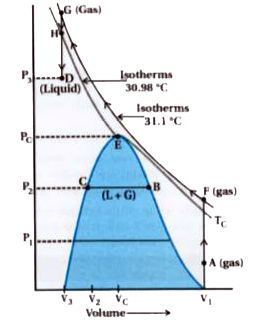Liquifasction occurs in different steps in same phase. - Explain with example. Solution in Gujrati
Process of convert gas into liquid or liquid into gas is possible in same phase.
e.g. : A(g)(i)−−→F(g)(ii)−−→G(g)(iii)−−→H(l)→D(l)
Liquifaction occurs in three steps in same phase.

Step - (i) (Point A to Point F) : We can move from point A to F vertically by increasing the temperature, pressure also increases.
Step - (ii) (Point F to Point G) : We can reach the point F to G by compressing the gas at the constant temperature along this isotherm (Isotherm at 31.1∘C). The pressure will increases.
Step - (iii) (Point G to Point D) : we can move vertically down towards G to D by lowering the temperature. As soon as we cross the point H on the critical isotherm we get liquid.
We end up with liquid but in this series of changes we do not pass through two phase region. If liquifaction is done by first critical temperature then substance situated always in one phase.
Topper's Solved these Questions
- BOOK - KUMAR PRAKASHANCHAPTER - STATES OF MATTER EXERCISE - SECTION - A QUESTIONS (Sub Question)3videos
STATES OF MATTER
- BOOK - KUMAR PRAKASHANCHAPTER - STATES OF MATTER EXERCISE - SECTION - A QUESTIONS (TRY YOUR SELF)47videos
STATES OF MATTER
- BOOK - KUMAR PRAKASHANCHAPTER - SOME BASIC CONCEPTS OF CHEMISTRYEXERCISE - Section - D (Solutions of NCERT Exemplar Problems) (Long Answer Type Questions)4videos
SOME BASIC CONCEPTS OF CHEMISTRY
- BOOK - KUMAR PRAKASHANCHAPTER - STRUCTURE OF ATOMEXERCISE - QUESTINS PAPER FROM MODULE (SECTION -D)2videos
STRUCTURE OF ATOM
Similar Questions
Derive Boyle.s formula according to his law.
02:13View SolutionAt 300 K constant temperature gas having 20cm3, 1 bar pressure it is convert into 50cm3 then calculated pressure ?
03:23View SolutionA vessel contains 1.6 g of dioxygen at STP (273.15 K, 1 atm pressure). The gas is now transferred to another vessel at constant temperature, where pressure becomes half of the original pressure. Calculate
(A) volume of the new vessel.
(B) number of molecules of dioxygen.03:15View SolutionExplain Heisenberg’s uncertainty principle.
05:41View SolutionExplain the different steps involved during primary treatement phase of sewage.
04:20View Solutionजीन क्लोनिंग के विभिन्न चरणों को समझाइए।
02:59View SolutionExplain the rate determining step with an example.
View SolutionExplain the different steps involved in translation.
05:45View SolutionGive an example of homogeneous catalysis occurring in gaseous phase
02:55View SolutionExplain the different steps in Mitosis?
02:06View SolutionExplain the rate determining step with an example .
09:49View SolutionExplain the different steps involved in translation.
03:27View SolutionExplain the events occurring in G1 phase in short.
04:50View SolutionExplain the different steps involved during primary treatement phase of sewage.
02:24View SolutionExplain the various steps occurring in lithosphere formation.
View Solution

